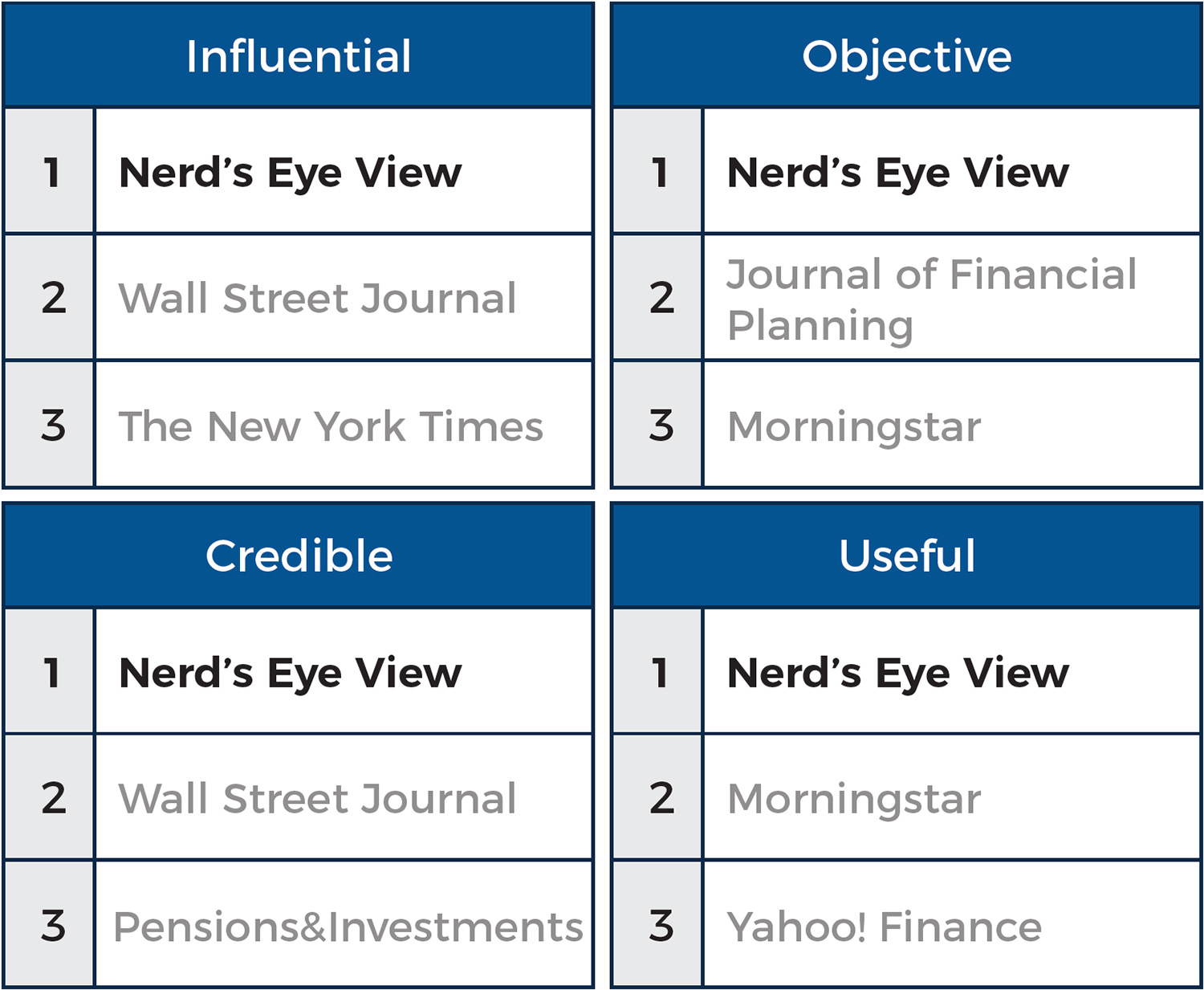Presentation Topics
Below is a list of a few of our speaking team’s most popular presentations. Please contact our team via the form at the end of this page if you wish to have us speak on a topic not listed, or if you are interested in a half-day or full-day workshop.
In addition, we are also available to participate as part of a panel, or in an “Ask Me Anything” style interview.
- Industry Trends/Keynotes
- Retirement
- Income Tax
- Investment
- Estate Planning
- Behavioral Finance
- Practice Management
- Ethics
Industry Trends/Keynotes
Five Industry Trends Reshaping Financial Advice
The recent rise of the “robo-advisor” has called into question the relevance of financial advisors and the viability of current advisory business models. Yet the reality is that technology “disrupting” financial advisor business models isn’t new, and has actually happened repeatedly over the past several decades… forcing advisors to adapt and move up the value chain, or be left behind. In this session, we look at how technology is once again driving major changes in the business model of financial advisors, driving a Great Convergence across historically-separate industry channels, triggering a Crisis of Differentiation, a Search for New Business Models, and rising pressure on improving the Client Experience. And in the coming years, these trends will only be accelerated, as the consumers of financial planning – and financial planners themselves – shift from Baby Boomers, to the Gen X and Millennial generations that, as “digital natives”, will expect and demand advisors to both leverage technology, and add value on top!
At The Capacity Crossroads: 3 Visions For Scaling The Advisory Firm You Want
Historically, the transactional brokerage models of financial advice meant that one could never have “too many” clients; at worst, advisors just focused on their biggest clients with the best repeat business opportunities. However, the rise of recurring revenue relationship-oriented models, from charging AUM fees to monthly subscription fees, introduces a material capacity limitation for advisory firms – any one financial advisor can only handle “so many” ongoing clients, before there simply isn’t enough time (or mental bandwidth) to serve any more. And with retention rates commonly 90%+ for most advisory firms, it’s virtually inevitable that any and every financial advisor will eventually hit their personal capacity wall after enough years in the business. Once they reach this Capacity Crossroads, though, advisors must make a decision about how to scale their firm going forward, as either a “Lifestyle” firm (maximizing income for the advisor and building a small team around them, but without any intention or desire to grow past themselves), a “Small Giant” that tries to grow focused businesses serving their particular type of clientele a particular way (and will accumulate more advisors/team over time to reach a growing number of those clients), or as an Enterprise-builders who aspires to build truly large advisory firm enterprise. In this session, we will explore the different approaches for how advisory firms scale, help advisors understand which type is the best fit for their own personal vision and goals, and give them perspective on what they should (and shouldn’t) be focused on based on their desired approach to scaling their advisory firm (i.e., what they should do/build, what they should hire, what they should NOT hire, and what they should outsource).
SECURE Act 2.0: Retirement Planning Opportunities and Challenges
The Setting Every Community Up for Retirement Enhancement (SECURE) Act, passed in December 2019, brought a wide range of changes to the retirement planning landscape, from the death of the ‘stretch’ IRA to raising the age for Required Minimum Distributions (RMDs) to 72, to provisions meant to encourage increased participation in workplace retirement plans. And now, Congress has given financial advisors and their clients another year-end development related to retirement planning, dubbed “SECURE 2.0”.
While no single change in SECURE 2.0 rises to the magnitude of the “Death of the Stretch” from the original SECURE Act, there are more total impactful changes in the new legislation. These include raising the RMD age again, allowing transfers of 529 account assets to Roth IRAs (with some significant restrictions), and adjusting the amount of allowed ‘catch-up’ contributions. The legislation also introduces new account types including SEP and SIMPLE Roth IRAs, as well as a “Starter” 401(k) plan. And for current retirees, key measures include reducing the penalties for missed Required Minimum Distributions (RMDs) and indexing the allowed amount of Qualified Charitable Distributions (QCDs) for inflation.
Scaling Advice: From Financial Advisor to Financial Advicer
The financial planning process is a valuable, but time-consuming, process. And the pressure of ‘spending the time’ to demonstrate the value is only amplified further as advisory firms grow a sizable base of clientele, and must support them in an ongoing manner after the initial financial plan is delivered. In this session, we explore the research on what actually makes the financial planning process more efficient and scalable, including the impact of advanced training and designations, how to develop more repeatable financial planning processes with an annual service calendar, how client variability impacts the efficiency of firms ad their planning processes, and the role that technology does (and does not) play in advisor efficiency.
RETHINKING ADVISOR MARKETING TO GENERATE MORE SCALABLE GROWTH
For decades, the most common way that established financial advisors grow is via referrals from their existing clients. And as a result, the average financial advisory firm spends just 2% of its revenue on marketing. Yet in practice, it’s not clear whether growing with referrals is really a best practice, or simply the only source of growth that’s left when advisory firms spend on little else to market their services! In this session, we delve into the latest Kitces Research on what financial advisors are actually doing to successfully market themselves, the typical cost to acquire new clients and how it varies by marketing channel, why some marketing strategies are significantly more scalable than others, and the best approach to determine the right budget for marketing expenses for your advisory firm!
Is My Advisory Firm Normal? 6 KPIs To Track & Compare
Every financial advisor builds their advisory firm to their unique vision of how they believe their clients should be served… which can create significant challenges in assessing the financial health of the business beyond “is it profitable (at all)”, and figuring out whether the firm is pricing its services properly, what its capacity should be, and how to determine whether its team is really being as productive as it should be. In this session, we explore some of the Key Performance Indicators that advisory firm owners can use to understand the financial health of the business, including what is a “normal” profit margin and overhead expense ratio, when an advisory firm should (or shouldn’t) expect to scale its EBOC, how to use revenue per advisor to assess productivity and capacity, and how to leverage revenue per employee as a key indicator of when to hire to grow sustainably.
AMA: Ask Michael Anything
This is an opportunity to take advantage of Michael’s vast knowledge base and create a session that is more personal to your audience. While this session does not include CE or slides, your audience can ask the questions that are on their minds and create a totally unique experience.
Retirement
Strategies For Managing Sequence Of Return Risk In Retirement
For long-term investors, the reality is that even if markets are volatile for a period of time, as long as the portfolio stays invested, returns can average out in the long run. In the case of retirees, however, ongoing spending withdrawals introduce the possibility that if the portfolio experiences weak returns early on, it could be depleted entirely before the good returns finally show up. As a result, retirees must consider this “sequence of returns” risk when planning for retirement, and strategies to manage it, from reducing spending in the first place, to engaging in more dynamic asset allocation to reduce risk exposure, or dynamic spending strategies to adapt spending withdrawals to market changes along the way!
Maximizing Social Security Benefits For Couples
The Bipartisan Budget Act of 2015 eliminated the popular File-and-Suspend and Restricted Application claiming strategies. In this webinar, we discuss how those claiming strategies worked, the timing of when they are being phased out under the new rules, and transition planning for couples, single individuals, divorcees, parents, and widows, given the new rules. We also explore the overall dynamics of when to take Social Security early versus delay, and how claiming strategies will shift in the future given the limitations of the new rules!
Advanced Roth Conversion Planning Strategies
The natural appeal of a Roth-style retirement account is the potential for tax-free growth for life. However, the reality is that creating a Roth account has a “cost” – the upfront tax liability of contributing to (or converting into) the account, which is avoided with a traditional pre-tax IRA or 401(k). As a result, optimal Roth strategies involve not merely contributing to or converting into Roths, but managing the timing and leveraging the available tax law to maximize the strategy. In this session, we explore techniques to maximize Roth contributions, including so-called “Backdoor Roth” IRAs and “Mega Backdoor Roth” 401(k) strategies, and leveraging the Roth recharacterization rules to optimally fill lower tax brackets, and be able to ensure that an investment in a Roth has a positive return before being required to commit to it!
Tax Efficient Withdrawal Strategies in Retirement
The traditional approach to liquidations in retirement is very straightforward: spend taxable dollars first, and let tax-deferred retirement accounts keep growing, because “no one” wants to pay taxes any sooner than they have to! Except the reality is that there really is such thing as “too much” tax-deferred compounding growth, which makes future retirement distributions so large it drives the retiree into higher tax brackets and results in less wealth! In this session, we explore a more effective tax-efficient withdrawal approach of equalizing tax brackets throughout life, by mixing together taxable, tax-deferred, and tax-free accounts over time, and leveraging strategies like systematic partial Roth conversions and even capital gains harvesting to smooth out tax brackets from year to year and reduce cumulative taxation throughout retirement!
IRA Planning for Baby Boomers (2 1/2 hr to 4 hr)
Americans currently hold over $30 trillion in retirement assets. As such, a sound understanding of the rules surrounding these accounts is an absolute must for any serious practitioner. Those who understand the ins and outs of IRA planning are poised to benefit from the wave of Baby Boomers that are, or soon will be, tapping into their retirement assets. Conversely, those without such knowledge risk losing relevance, or worse, making the costly and irrevocable mistakes that can derail clients’ plans.
Realizing the Potential of Net Unrealized Appreciation
The number of individuals with large portions of their wealth in retirement plans is growing. Even though most individuals have a handful of options once they have separated from service, many choose what is typically the worst option, a lump sum distribution. In fact, research finds that this happens about 30% of the time! In this session advisors will learn about the nuances involving lump sum distributions, and how to make the most out of the worst situation by taking a deep dive into Net Unrealized Appreciation (NUA). Learn when and why utilizing NUA makes sense, as well as situations where it does not make sense, and the important rules surrounding the strategy.
Managing and Minimizing RMD Obligations
A sound understanding of the RMD rules by advisors is a necessity, as RMDs are one aspect of retirement distribution planning that impacts nearly all clients at one point or another. Add to that the mass of Baby Boomers – the oldest of which are now in their 70s – who need RMD help and it’s easy to see a golden opportunity awaits the educated advisor. Sadly though, evidence shows that most advisors vastly overestimate their knowledge of core RMD rules, which can lead to disastrous consequences. In this program, advisors will learn about RMDs from the “ground up” to ensure they can give sound advice for years to come. Special focus will be paid to the intricacies and nuances of this deceivingly complex aspect of the law so that advisors can help clients correct mistakes that have already occurred and avoid others before they even happen.
Rethinking Monte Carlo Results for Better Client Conversations
The Monte Carlo analysis is a great financial planning tool, but it is not without its drawbacks.
For instance, it is uni-dimensional, focusing only on the probability of success. And certainly,
success is good, but the Monte Carlo does not ensure success nor does it tell a client what to do
when the plan is no longer successful, which is the larger issue. Join us for this month’s webinar
and learn how to adapt the Monte Carlo analysis, making it more useful and tangible for clients.
Advisors will learn practical conversation tips and approaches for working with clients and begin
to think about the Monte Carlo analysis in a new light.
How Real Retirement Spending Patterns Change Traditional Retirement Withdrawal Strategies (1 hr)
This presentation examines how real retirement spending patterns change traditional retirement withdrawal strategies. Specifically, commonly used retirement spending assumptions are compared to actual retirement spending patterns of retirees. This comparison reveals that typical assumptions of constant real spending often overstates retirement spending. As a result, commonly assumptions may overstate retirement savings need. Accounting for more realistic retirement spending results in higher safe withdrawal rates than prior research has typically indicated. Typical assumptions also fail to account for the potential to make adjustments in retirement that can keep a retirement spending plan on track.
How Earnings Growth Throughout The Lifecycle Impacts Retirement Savings Strategies (1 hr)
This presentation examines how earnings growth throughout the lifecycle impacts retirement savings strategies. Specifically, traditional earnings growth assumptions utilized in safe savings rate analyses are compared to actual Social Security data on earnings growth across the lifecycle. This comparison reveals that typical assumptions of constant real earnings often understates income growth in earlier years, while overstating income growth in later years. As a result, assumptions regarding both saving during one’s working years and spending during retirement may not accurately reflect the outcomes that are most likely. Accounting for more realistic earnings curves results in lower “safe” savings rates than research has typically indicated—particularly among lower income Americans. Typical assumptions also fail to account for the potential to capture greater earnings growth as one’s savings increase, as well as the decline in retirement savings need that corresponds with declining real earnings experienced in late, pre-retirement years.
Seamlessly Integrating Social Security Benefits into a Client’s Retirement Plan
Social Security benefits are a bedrock element of most retirement plans. Unfortunately, the litany of rules that govern such benefits, including those that determine eligibility, taxation, timing, and calculation, are incredibly complicated, making it difficult for clients and advisors alike to determine the best course of action.
In this session, attendees will take a deep dive into the rules that surround various types of benefits provided by the Social Security Administration, including retirement benefits, spousal benefits and survivor benefits. Attendees will also explore how delaying Social Security benefits compares to other options, how the special formula for determining the taxable amount of Social Security can dramatically impact net benefits, how losing benefits to the Earnings Test can actually result in greater lifetime benefits, and much more.
529 Planning: 529-to-Roth, Dynasty 529, And Other HNW Opportunities
Over the past few decades, higher education costs have increased at a pace far exceeding inflation. In an effort to help save for such costs, many families have turned to 529 plans. While the basic mechanics of such plans are well understood by most advisors, 529 planning can become surprisingly complex, especially when planning for multiple (generations of) potential students, or when 529 plan funds are used for purposes other than higher education. Lead Financial Planning Nerd, Jeff Levine, explores many of these complexities and take a deep dive into some of the more challenging aspects of 529 planning.
10 Essential IRA Planning Strategies for 2025
For more than 40 years, IRAs have been available as a retirement-savings vehicle, but the rules surrounding them are constantly changing, and they are incredibly – and deceptively – complex. Each year, client mistakes, advisor errors and oversights by financial institutions cost clients millions of dollars in unnecessary taxation. This session seeks to reverse that trend by helping advisors to identify and avoid 10 of the most frequent and costly IRA mistakes.
Planning Strategies to Mitigate the Impact of the 10-Year Rule
The “Setting Every Community Up For Retirement Enhancement (SECURE) Act” introduced substantial updates to long-standing retirement account rules. One notable change was the elimination of the ‘stretch’ provision for most non-spouse designated beneficiaries of retirement accounts and the introduction of a new “10-Year Rule.” This has resulted in a substantially compressed timeframe over which distributions from many inherited retirement accounts may be spread, increasing the likelihood that more of these accounts will be taxed at higher rates. Thankfully, though, with proper planning, the potential for increased taxation can be significantly mitigated, preserving more of a client’s hard-earned, unused, retirement savings for their heirs.
To assist clients in this type of planning, attendees of this session will take a deep-dive into the current rules for post-death distributions, including the latest guidance from the IRS on the implementation of the 10-Year Rule. The session will also explore strategies that can be used by retirement account owners to help reduce taxes for their future beneficiaries, as well as strategies that can be used by those beneficiaries to minimize their own taxes. This session incorporates the impact of the New IRS Final Regs.
Helping Nervous Clients Understand And Financially Plan For The (True) State Of The Social Security System
Given frequent news headlines on the (un)sustainability of the Social Security system, many working-age financial advisory clients might harbor doubts about receiving their full (or any of their) estimated Social Security benefits. In this session, we dive deep into data from the Social Security Board Of Trustees’ Annual Report to clear up common misconceptions about the actual health of the Social Security system, review a range of policy options being considered to shore up Social Security for the rest of the century, and discuss how financial advisors can analyze the impact of these policies for both working-age, near-retirement, and already-retired clients, and ways to adapt financial planning assumptions to model the scenarios, providing clients with a more accurate picture of how they might (or might not) be affected.
Income Tax
An Advisor’s Guide to the New 20% Pass-Through Deduction
For many business-owner clients, one of the most significant changes made by the Tax Cuts and Jobs Act (TCJA) was the creation of the new 199A deduction. This deduction, better known as the 20% pass-through deduction, has the potential to be one of the biggest tax-savers for certain clients, but it’s also undoubtedly one of the most complicated provisions in the entire TCJA. The good news is that since the enactment of the TCJA, the IRS has issued a substantial amount of guidance intended to clarify varying aspects of the new provision. The bad news is that much of that guidance is counter-intuitive to what one might expect by simply reading the plan language of the statute. Advisors who can quickly and thoroughly learn the intricate ins and outs of the 199A deduction will easily stand out from the competition.
Principles Of Tax Planning for Financial Advisors
Financial Advisors serve clients with a diverse array of backgrounds, financial resources, goals, and objectives. But while no two clients are the same, nearly all clients share the common goal of “paying the least amount of tax possible.” It should come as no surprise then, that clients of all income and asset levels are increasingly seeking “tax planning” guidance from their Financial Advisors.
Many advisors, though, have been reticent to engage in tax planning, either because they lack the knowledge to be able to competently do so, fear “stepping on the toes” of a client’s CPA or other tax professionals, or out of concern about running afoul of rules that prevent them from giving tax advice. This session seeks to address those concerns.
Attendees will begin by learning why including tax planning as part of their overall client experience is essential for continued growth and success. The session will then focus on exploring ten high level principals of tax planning that can be used by all advisors – from tax planning “newbies” to seasoned tax planning pros – to help guide their clients towards lower tax bills and better outcomes.
SECURE Act 2.0: Retirement Planning Opportunities and Challenges
The Setting Every Community Up for Retirement Enhancement (SECURE) Act, passed in December 2019, brought a wide range of changes to the retirement planning landscape, from the death of the ‘stretch’ IRA to raising the age for Required Minimum Distributions (RMDs) to 72, to provisions meant to encourage increased participation in workplace retirement plans. And now, Congress has given financial advisors and their clients another year-end development related to retirement planning, dubbed “SECURE 2.0”.
While no single change in SECURE 2.0 rises to the magnitude of the “Death of the Stretch” from the original SECURE Act, there are more total impactful changes in the new legislation. These include raising the RMD age again, allowing transfers of 529 account assets to Roth IRAs (with some significant restrictions), and adjusting the amount of allowed ‘catch-up’ contributions. The legislation also introduces new account types including SEP and SIMPLE Roth IRAs, as well as a “Starter” 401(k) plan. And for current retirees, key measures include reducing the penalties for missed Required Minimum Distributions (RMDs) and indexing the allowed amount of Qualified Charitable Distributions (QCDs) for inflation.
Seamlessly Integrating Social Security Benefits into a Client’s Retirement Plan
Social Security benefits are a bedrock element of most retirement plans. Unfortunately, the litany of rules that govern such benefits, including those that determine eligibility, taxation, timing, and calculation, are incredibly complicated, making it difficult for clients and advisors alike to determine the best course of action.
In this session, attendees will take a deep dive into the rules that surround various types of benefits provided by the Social Security Administration, including retirement benefits, spousal benefits and survivor benefits. Attendees will also explore how delaying Social Security benefits compares to other options, how the special formula for determining the taxable amount of Social Security can dramatically impact net benefits, how losing benefits to the Earnings Test can actually result in greater lifetime benefits, and much more.
Tax Planning for S Corporations: Benefits, Limitations, and Strategies
S Corporations, and their taxation, are of interest for financial planners as much as they are for financial planning clients. For instance, what is “reasonable compensation”? Or how is the health insurance premium handled? – These are questions financial planners have to answer for clients as well as sometimes for themselves. This session will arm financial advisors with the benefits, limitations, and strategies for S-Corps that they can share with clients and use for themselves.
HSA Planning: Maximizing Tax-Advantaged Savings For Clients' Health Care Expenses
Health Savings Accounts (HSAs) can be a powerful savings tool for middle-income savers, owing to their combination of tax-deductible contributions, tax-free growth, and tax-free withdrawals for qualified medical expenses. And because there’s no time limit for HSA funds to be used during their owner’s lifetime, it’s possible to save and invest them over years or decades, and even to use HSAs as a source of tax-free income in retirement – not only to pay for health care costs during retirement, but also to reimburse any (not-previously-reimbursed) expenses that were incurred any time after the account was opened. By understanding the rules around HSAs – including when individuals and families are eligible to contribute (and how much they can contribute each year), which expenses are eligible (and what records the IRS requires to substantiate them), and what happens to an HSA in the event that the account owner dies – advisors can help their clients navigate HSA planning and get the most out of their tax-advantaged health savings.
Advanced 529 Planning: 529-to-Roth, Dynasty 529, And Other HNW Opportunities
Over the past few decades, higher education costs have increased at a pace far exceeding inflation. In an effort to help save for such costs, many families have turned to 529 plans. While the basic mechanics of such plans are well understood by most advisors, 529 planning can become surprisingly complex, especially when planning for multiple (generations of) potential students, or when 529 plan funds are used for purposes other than higher education. Lead Financial Planning Nerd, Jeff Levine, explores many of these complexities and take a deep dive into some of the more challenging aspects of 529 planning
Going Deeper On Taxes Compliantly: Tax Planning Vs. Tax Advice
In this session, advisors will gain a comprehensive understanding of the types of tax advice they cannot provide without being a designated tax practitioner, such as a CPA, EA, or attorney. Explore the allowable types of tax advice from a legal standpoint, while also recognizing the potential liabilities for advisors and their firms in the absence of proper procedures for competent and client-centric tax advice. Discover the nuances between tax planning and tax advice, and learn best practices for advisors to add value through tax planning when direct tax advice may not be an option.
Tax Planning For TCJA's (Scheduled) Sunset: Preparing Clients For Change Amid Legislative Uncertainty
The Tax Cuts and Jobs Act (TCJA) of 2017 introduced a great many changes to the individual tax system, from a restructuring of the tax brackets themselves to shifts in the amount and number of deductions, exemptions, and credits available to taxpayers. But the caveat is that most of TCJA’s provisions are scheduled to expire at the end of 2025, which means that taxpayers are set to undergo the second major tax overhaul in the last 10 years, even if it’s just as a result of going back to the “old” system. In many cases, taxpayers will slightly higher tax rates on their taxable income; however, a reduced standard deduction, more available itemized deductions, restoration of personal exemptions, reductions in the Alternative Minimum Tax (AMT) exemptions and phaseout levels, and the elimination of the Sec. 199A deduction on Qualified Business Income QBI will each have a significant impact on the amount of tax people actually pay. Meanwhile, TCJA’s sunset will reduce the gift and estate tax exemption by 50%, potentially subjecting many more families to estate tax after 2025 (unless they take action to gift or transfer assets from their estate to take advantage of today’s higher exemption). And even though it’s uncertain whether some or all of TCJA will be extended, modified, or allowed to expire (which will ultimately be decided after the 2024 elections and legislative negotiations to follow), tax planners will benefit from knowing what aspects of their clients’ tax pictures stand to change as a result of TCJA’s sunset and what planning opportunities exist so they can take action once there’s more certainty.
Tax Planning Opportunities Under The New "One Big Beautiful Bill” Act
The “One Big Beautiful Bill Act” (OBBBA), which was signed into law on July 4, 2025, put to rest years of uncertainty over whether the tax rules created by the Tax Cuts and Jobs Act of 2017 would be extended or allowed to sunset at the end of 2025. At the same time, however, it also included a host of new provisions that will introduce new planning considerations for clients of financial advisors.
In this session, Kitces Senior Financial Planning Nerd Ben Henry-Moreland will provide a detailed overview of the changes brought about by the OBBBA and discuss tax planning strategies that clients of financial advisors can implement now that the law is finalized. He’ll be covering the OBBBA’s tax-related provisions including the increased SALT deduction, additional deduction for seniors age 65+, increased gain exclusion for qualified small business stock, renewed qualified opportunity zone investments, and new 529 plan eligible expenses. He’ll also cover planning implications of the new bill, ranging from new considerations for individuals making Roth conversions, changes to charitable deduction strategies, estate planning techniques, and more!
Investment
An In-Depth Look At Optimal Rebalancing Strategies
The conventional view of rebalancing is that it’s a way to enhance long-term returns for investors while keeping their portfolio on target to achieve long-term goals. The reality, though, is that when rebalancing across different asset classes like stocks and bonds, systematic rebalancing is more likely to reduce returns, albeit with the benefit of also reducing risk. And for those who wish to engage in the strategy, it’s still necessary to consider the optimal frequency for rebalancing – which, as it turns out, is not based on a fixed time horizon like monthly, quarterly, or annual rebalancing, but instead is best done by targeting asset allocation thresholds at which a rebalancing trade will trigger (however long it takes to get there!).
Generating Tax Alpha With Effective Asset Location (1 hr)
While it is ‘standard’ for advisors to diversify into an asset allocated portfolio, the question of where to locate those asset classes is more challenging. In this session, we will explore the various ways to handle asset location, taking into consideration tax efficiency, expected returns, and time horizons. We also take a look at how to build, use, and implement an asset location priority list based on the expected return and the tax efficiency of various assets. Finally, we review the caveats and concerns of asset location and approximate the value of utilizing an asset location strategy with your clients.
Estate Planning
Trusts as Beneficiaries of IRAs (1 hr)
As the use of trusts in estate planning becomes increasingly popular for both tax and non-tax reasons, and clients continue to accumulate more and more assets in retirement accounts, the use of trusts as beneficiaries of IRAs is increasing desirable and necessary. Unfortunately, though, the rules pertaining to IRAs payable to a trust after death are complex and challenging. In this session, we will explore the unique requirements for IRAs to preserve and maximize their tax deferral after death when a trust is the beneficiary, with details about the rules for trusts to qualify for the IRA’s post-death tax deferral “stretch,” how to calculate the actual post-death required minimum distributions for the trust, and examples of specific wording from sample trusts.
Estate Planning For Income Taxes: Maximizing Basis Planning Opportunities
Given recent changes in the law, “tax planning” for one’s estate at death has become a lot less about estate tax planning, and far more about the income tax planning opportunities at death… particularly with respect to maximizing available step-up in basis opportunities. With that in mind, attendees of this session will explore topics including how pre-death asset transfers can help maximize step-up in basis, how other types of pre-death transfers can help avoid the potential for a step-down in basis, complications associated with these strategies for clients living in community property states, and the disadvantages of traditional credit shelter trusts that emerge in an estate planning environment driven by income- (rather than estate-)tax planning.
HSA Planning: Maximizing Tax-Advantaged Savings For Clients' Health Care Expenses
Health Savings Accounts (HSAs) can be a powerful savings tool for middle-income savers, owing to their combination of tax-deductible contributions, tax-free growth, and tax-free withdrawals for qualified medical expenses. And because there’s no time limit for HSA funds to be used during their owner’s lifetime, it’s possible to save and invest them over years or decades, and even to use HSAs as a source of tax-free income in retirement – not only to pay for health care costs during retirement, but also to reimburse any (not-previously-reimbursed) expenses that were incurred any time after the account was opened. By understanding the rules around HSAs – including when individuals and families are eligible to contribute (and how much they can contribute each year), which expenses are eligible (and what records the IRS requires to substantiate them), and what happens to an HSA in the event that the account owner dies – advisors can help their clients navigate HSA planning and get the most out of their tax-advantaged health savings.
Planning Strategies to Mitigate the Impact of the 10-Year Rule
The “Setting Every Community Up For Retirement Enhancement (SECURE) Act” introduced substantial updates to long-standing retirement account rules. One notable change was the elimination of the ‘stretch’ provision for most non-spouse designated beneficiaries of retirement accounts and the introduction of a new “10-Year Rule.” This has resulted in a substantially compressed timeframe over which distributions from many inherited retirement accounts may be spread, increasing the likelihood that more of these accounts will be taxed at higher rates. Thankfully, though, with proper planning, the potential for increased taxation can be significantly mitigated, preserving more of a client’s hard-earned, unused, retirement savings for their heirs.
To assist clients in this type of planning, attendees of this session will take a deep-dive into the current rules for post-death distributions, including the latest guidance from the IRS on the implementation of the 10-Year Rule. The session will also explore strategies that can be used by retirement account owners to help reduce taxes for their future beneficiaries, as well as strategies that can be used by those beneficiaries to minimize their own taxes. This session incorporates the impact of the New IRS Final Regs.
Behavioral Finance
Applying Behavioral Finance In Your Financial Planning Practice (1 hr)
An increasing volume of research is making clear what financial planners have long known – that clients do not always act in a purely rational manner. But it’s one thing to recognize that clients sometimes make irrational decisions, and another to really understand what drives those decisions and how to help clients avoid the most damaging mistakes. In this session, advisors will learn what the behavioral finance research has shown about our not-always-rational decision-making process, and how to consider making adjustments to the delivery of their financial planning services to help clients achieve more desirable outcomes through better communication and enhanced trust.
Practice Management
Rethinking Advisor Marketing To Generate More Scalable Growth
For decades, the most common way that established financial advisors grow is via referrals from their existing clients. And as a result, the average financial advisory firm spends just 2% of its revenue on marketing. Yet in practice, it’s not clear whether growing with referrals is really a best practice, or simply the only source of growth that’s left when advisory firms spend on little else to market their services! In this session, we delve into the latest Kitces Research on what financial advisors are actually doing to successfully market themselves, the typical cost to acquire new clients and how it varies by marketing channel, why some marketing strategies are significantly more scalable than others, and the best approach to determine the right budget for marketing expenses for your advisory firm!
At The Capacity Crossroads: 3 Visions For Scaling The Advisory Firm You Want
Historically, the transactional brokerage models of financial advice meant that one could never have “too many” clients; at worst, advisors just focused on their biggest clients with the best repeat business opportunities. However, the rise of recurring revenue relationship-oriented models, from charging AUM fees to monthly subscription fees, introduces a material capacity limitation for advisory firms – any one financial advisor can only handle “so many” ongoing clients, before there simply isn’t enough time (or mental bandwidth) to serve any more. And with retention rates commonly 90%+ for most advisory firms, it’s virtually inevitable that any and every financial advisor will eventually hit their personal capacity wall after enough years in the business. Once they reach this Capacity Crossroads, though, advisors must make a decision about how to scale their firm going forward, as either a “Lifestyle” firm (maximizing income for the advisor and building a small team around them, but without any intention or desire to grow past themselves), a “Small Giant” that tries to grow focused businesses serving their particular type of clientele a particular way (and will accumulate more advisors/team over time to reach a growing number of those clients), or as an Enterprise-builders who aspires to build truly large advisory firm enterprise. In this session, we will explore the different approaches for how advisory firms scale, help advisors understand which type is the best fit for their own personal vision and goals, and give them perspective on what they should (and shouldn’t) be focused on based on their desired approach to scaling their advisory firm (i.e., what they should do/build, what they should hire, what they should NOT hire, and what they should outsource).
Scaling Advice: From Financial Advisor to Financial Advicer
The financial planning process is a valuable, but time-consuming, process. And the pressure of ‘spending the time’ to demonstrate the value is only amplified further as advisory firms grow a sizable base of clientele, and must support them in an ongoing manner after the initial financial plan is delivered. In this session, we explore the research on what actually makes the financial planning process more efficient and scalable, including the impact of advanced training and designations, how to develop more repeatable financial planning processes with an annual service calendar, how client variability impacts the efficiency of firms ad their planning processes, and the role that technology does (and does not) play in advisor efficiency.
Accelerating Growth By Marketing How You’re Different (Instead Of Better)
When marketing to prospective clients, many firms try to show how they are ‘better’ than other firms, for example by their status as a fiduciary, fee-only advisor offering comprehensive planning services. While these can be important characteristics, they are not necessarily the differentiators they once were, with even the largest asset managers adopting similar language in their marketing. In this session, we discuss how advisors can focus on what makes them different, instead of the slippery slope of forever trying to be better in an increasingly competitive advisor landscape. Leveraging Kitces Research data and real-world examples from advisory firms, we explore how advisors can decide what makes them different and options for how they can communicate their unique value proposition on their websites to show why they are the best advisor for their ideal target client.
Is My Advisory Firm Normal? 6 KPIs To Track & Compare
Every financial advisor builds their advisory firm to their unique vision of how they believe their clients should be served… which can create significant challenges in assessing the financial health of the business beyond “is it profitable (at all)”, and figuring out whether the firm is pricing its services properly, what its capacity should be, and how to determine whether its team is really being as productive as it should be. In this session, we explore some of the Key Performance Indicators that advisory firm owners can use to understand the financial health of the business, including what is a “normal” profit margin and overhead expense ratio, when an advisory firm should (or shouldn’t) expect to scale its EBOC, how to use revenue per advisor to assess productivity and capacity, and how to leverage revenue per employee as a key indicator of when to hire to grow sustainably.
Ethics
Navigating Ethical Obligations As A Financial Planner
In this engaging and thought-provoking presentation, Shelitha Smodic, CFP® delves into the ethical considerations and responsibilities of financial planners. She explores the intricate balance between client relationships, fiduciary duty, and personal integrity as we navigate the complex ethical landscape in the financial industry. This program fulfills the requirement for CFP Board Ethics CE under the CFP Board’s new Code of Ethics and Standards of Conduct, effective October 1, 2019.






















